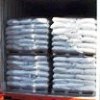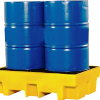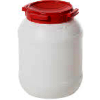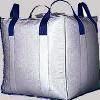Potassium Chloride BP USP IP ACS Analytical Reagent FCC Food Grade Manufacturers Suppliers India
Anmol Chemicals are manufacturers of Specialty Chemicals and Pharmaceutical Excipients, in India. Anmol Chemicals Group has manufacturing facilities spread across India, representatives in Houston Chicago USA and toll manufacturers in China. We make IP, BP, USP, Ph Eur, FCC or Food Grade, ACS, AR or Analytical Reagent Grade, LR or Laboratory Reagent Grade and Pure Grades of various chemicals. All our items are analyzed to meet the required standards.
Our manufacturing facility is FDA GMP approved and ISO-9001, ISO 14000, OHSAS 18000, ISO 22000, FSSAI HACCP certified. We are offering products manufactured as per Kosher and Halal approved method. We are pre-registered with "Reach" for export to European countries.
The corresponding Mineral is Muriate of Potash or MOP
CAS No.: 7447-40-7; Molecular Weight: 74.5; Chemical Formula: KCl
Potassium Chloride USP Specifications
Potassium Chloride USP
KCl 74.55
Assay— Potassium Chloride contains not less than 99.0 percent and not more than 100.5 percent of KCl, calculated on the dried basis.
Packaging and storage— Preserve in well-closed containers.
Labeling— Where intended for use in hem dialysis, it is so labeled.
Identification— A solution (1 in 20) responds to the tests for Potassium and for Chloride.
Acidity or alkalinity— To a solution of 5.0 g in 50 mL of carbon dioxide–free water add 3 drops of phenolphthalein TS: no pink color is produced. Then add
0.30 mL of 0.020 N sodium hydroxide: a pink color is produced.
Loss on drying — Dry it at 105 for 2 hours: it loses not more than 1.0% of its weight.
Iodide or bromide—
IODIDE—
Standard stock solution— Transfer an accurately weighed quantity, about 41 mg, of potassium iodide to a 25-mL volumetric flask. Dissolve in and
dilute with water to volume, and mix.
Standard solution— Dilute 1.0 mL of Standard stock solution with water to 25 mL, and mix. Dilute 2.0 mL of this solution
with water to 8 mL, and proceed as directed for Test solution beginning with “Add 1 mL each of chloroform”.
Test solution— Dissolve 2 g in 8 mL of water. Add 1 mL each of chloroform and diluted hydrochloric acid, then add 2 drops of a chloramine T solution (0.1 in 100),
and shake gently. The violet color of the chloroform layer is not darker than that of a concomitantly prepared Standard solution: the limit is 0.005%.
BROMIDE—
Standard solution— Transfer an accurately weighed quantity, about 32 mg, of sodium bromide to a 25-mL volumetric flask. Dissolve in and dilute with water
to volume, and mix. Dilute 2.0 mL of this solution with water to 8 mL, and proceed as directed for Test solution beginning with “Add 1 mL each of chloroform”.
Test solution— Dissolve 2 g in 8 mL of water. Add 1 mL each of chloroform and diluted hydrochloric acid, then add 5 drops of a chloramine T solution (1 in 100),
and shake gently. The brown color of the chloroform layer is not darker than that of a concomitantly prepared Standard solution: the limit is 0.1%.
Aluminum— where it is labeled as intended for use in hem dialysis— Proceed as directed using 2.0 g of Potassium Chloride to prepare the Test Preparation: the
limit is 1 µg per g.
Calcium and magnesium— To 20 mL of a solution (1 in 100) add 2 mL each of 6 N ammonium hydroxide, ammonium oxalate TS, and dibasic sodium phosphate TS: no
turbidity is produced within 5 minutes.
Sodium— A solution (1 in 20), tested on a platinum wire, does not impart a pronounced yellow color to a non-luminous flame.
Heavy metals— Dissolve 2.0 g in 25 mL of water: the limit is 0.001%.
Organic volatile impurities: meets the requirements.
Potassium Chloride BP Specifications
Potassium Chloride BP
KCl 74.55
DEFINITION
Content
99.0 per cent to 100.5 per cent of KCl (dried substance).
CHARACTERS
Appearance
White or almost white, crystalline powder or colorless crystals.
Solubility
Freely soluble in water, practically insoluble in anhydrous ethanol.
IDENTIFICATION
It gives the reactions of chlorides.
Solution S gives the reactions of potassium.
TESTS
Solution S
Dissolve 10.0 g in carbon dioxide-free water R prepared from distilled water R and dilute to 100 ml with the same solvent.
Appearance of solution: Solution S is clear and colorless.
Acidity or alkalinity: To 50 ml of solution S add 0.1 ml of bromothymol blue solution. Not more than 0.5 ml of 0.01 M hydrochloric acid or 0.01 M sodium
hydroxide is required to change the color of the indicator.
Bromides: Maximum 0.1 per cent.
Iodides: Moisten 5 g by the drop wise addition of a freshly prepared mixture of 0.15 ml of sodium nitrite solution, 2 ml of 0.5 M sulphuric acid, 25 ml of
iodide-free starch solution and 25 ml of water. After 5 min, examine in daylight. The substance shows no blue color.
Sulphates: Maximum 300 ppm.
Aluminium: Maximum 1.0 ppm, if intended for use in the manufacture of hem dialysis solutions.
Barium: To 5 ml of solution S add 5 ml of distilled water and 1 ml of dilute sulphuric acid. After 15 min, any opalescence in the solution is not more intense
than that in a mixture of 5 ml of solution S and 6 ml of distilled water.
Iron: Maximum 20 ppm.
Magnesium and alkaline-earth metals: Maximum 200 ppm, calculated as Ca.
Sodium: Maximum 0.10 per cent, if intended for use in the manufacture of parenteral preparations or hem dialysis solutions.
Heavy metals: Maximum 10 ppm.
Loss on drying: Maximum 1.0 per cent, determined on 1.000 g by drying in an oven at 105 C for 3h.
Potassium Chloride FCC Food Grade US Food Chemical Codex
Potassium Chloride
KCl 74.55
Formula wt 74.55
DESCRIPTION: Potassium Chloride occurs as colorless, elongated, prismatic, or cubical crystals, or as a white, granular powder. It is stable in air. Its
solutions are neutral to litmus. It may contain up to 1.0% (total) of suitable food-grade ant-caking, free-flowing, or conditioning agents such as calcium stearate
or silicon dioxide, either singly or in combination. One gram dissolves in 2.8 mL of water at 25°, and in about 2 mL of boiling water. Potassium Chloride containing
anti-caking, free-flowing, or conditioning agents may produce cloudy solutions or dissolve incompletely. It is insoluble in alcohol.
Function: Nutrient; gelling agent; salt substitute; yeast food.
REQUIREMENTS:
Identification: A 1:20 aqueous solution gives positive tests for Potassium and for Chloride.
Assay: Not less than 99.0% of KCl after drying; and not less than 98.0% of KCl after drying when a sample contains added substance.
Acidity or Alkalinity: A sample containing no added substance passes test.
Heavy Metals (as Pb): Not more than 5 mg/kg.
Iodide and/or Bromide: Passes test.
Loss on Drying: Not more than 1.0%.
Sodium: Passes test.
Potassium Chloride ACS Analytical Reagent Specifications
American Chemical Society Reagent Grade
Potassium Chloride KCl
Formula Wt 74.55
CAS Number 7447-40-7
REQUIREMENTS
Assay: ---------------------- 99.0-100.5% KCl
pH of a 5% solution --------- 5.4-8.6 at 25C
MAXIMUM ALLOWABLE
Insoluble matter ------------ 0.005%
Iodide (I) ------------------ 0.002%
Bromide (Br) ---------------- 0.01%
Chlorate and nitrate (as NO3) 0.003%
Nitrogen compounds (as N) --- 0.001%
Phosphate (PO4) ------------- 5 ppm
Sulfate (SO4) --------------- 0.001%
Barium (Ba) ----------------- Passes test
Heavy metals (as Pb) -------- 5 ppm
Iron (Fe) ------------------- 3 ppm
Calcium (Ca) ---------------- 0.002%
Magnesium (Mg) -------------- 0.001%
Sodium (Na) ----------------- 0.005%

Manufacturers
ANMOL CHEMICALS
S-8, SARIFA MANSION, 2ND PRINCIPAL SHAIKH HASAN MARG, MUMBAI 400009, INDIA
TEL: (OFF) 91-22-23726950, 23774610, 23723564. FAX: 91-22-23728264
e-mail: info@anmol.org
Copyright and Usual Disclaimer is Applicable
Exporters to USA, UAE, Europe, South Africa, Tanzania, Kenya, Egypt, Turkey, Nigeria, Uganda, Brazil, Chile, Argentina, Dubai etc.
Representatives in New York, Houston - Texas, Chicago - Illinois, Los Angeles.
Fast Selling IP BP USP ACS FCC Food Grades of Chemicals by Anmol Chemicals
Aluminum Chloride ---------- Ammonium Sulfate ----- Ammonium Persulfate
Aluminum Potassium Sulfate - Ammonium Chloride ---- Ammonium Bicarbonate
Ammonium Carbonate --------- Benzyl Alcohol ------- Boric Acid
Benzoic Acid --------------- Borax; Sodium Borate - Calcium Chloride
Calcium Hydroxide ---------- Calcium Acetate ------ Calcium Butyrate
Calcium Lactobionate ------- Calcium Levulinate --- Calcium Saccharate
Carbamide Peroxide --------- Citric Acid ---------- Calcium Phosphate
Calcium Oxide -------------- Calcium Sulfate ------ Chromic Chloride
Cupric Chloride ------------
Ferric Chloride ------------ Ferric Nitrate ------- Fumaric Acid
Gentian Violet ------------- Glacial Acetic Acid
Lactobionic Acid ----------- Magnesium Butyrate
Magnesium Oxide ------------ Magnesium Chloride --- Magnesium Sulfate
Malic Acid ----------------- Maleic Acid ---------- Manganese Chloride
Manganese Sulfate ---------- Methylene Blue ------- Oleic Acid
Octyldodecanol -------------
Propylene Carbonate -------- Potassium Acetate ---- Potassium Carbonate
Potassium Hydroxide -------- Potassium Chloride --- Potassium Phosphate
Potassium Bitartrate ------- Propylene Carbonate -- Selenious acid
Sodium Molybdate ----------- Sodium Perborate ----- Sodium Phosphate
Sodium Propionate ---------- Sodium Acetate ------- Sodium Bicarbonate
Sodium Hydroxide ----------- Sodium Chloride ------ Sodium Thiosulfate
Sodium Selenite ------------ Urea ----------------- Zinc Chloride
Other Best Selling Products
Ammonium Bromide ----------- Ammonium Phosphate --- Barium Chloride
Butylated Hydroxyanisole --- Butylated Hydroxytoluene
Calcium Nitrate Nitrite ---- Calcium Propionate --- Copper Sulfate
Ceric Ammonium Nitrate ----- Cinnamaldehyde ------- Isatoic Anhydride
Directly Compressible Calcium Carbonate ----------- Encapsulated Citric Acid
Encapsulated Fumaric Acid -- Encapsulated Sodium Bicarbonate -
Encapsulated Sorbic Acid
Potassium Bromide ---------- Potassium Iodide ----- Potassium Nitrate Nitrite
Sodium Bromate ------------- Skatole -------------- Sodium Butyrate
Sodium Nitrite & Nitrate --- Sodium Bromide ------- Sodium Diacetate
Sodium Formaldehyde Bisulfite Strontium Chloride -- Stannous Chloride
TBHQ Tertiary Butylhydroquinone












